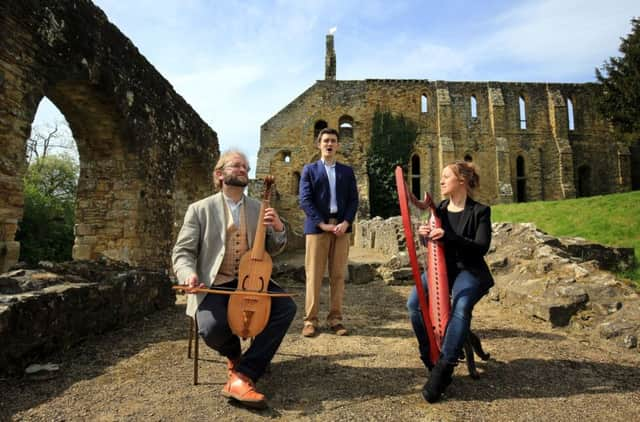Abbey Easter from a monk who doodled a carol 500 years ago


Be Merry had been written by a medieval monk, its lyric scrawled alongside a poem and a selection of potions for treating gastric flu. Its popularity among his contemporaries is not recorded, but we do know that it has been 500 years since it was last requested.
It has been resurrected, set to music and recorded as part of an exhibition about the monastic order at the abbey founded to commemorate the Battle of Hastings.
Advertisement
Hide AdAdvertisement
Hide AdThe historian who unearthed it said that given its vintage, a springtime premiere was not out of keeping. Religious carols were performed not just in church during medieval times but at social occasions all year long, often accompanied by song and dance.
Dr Michael Carter had come across what he described as “doodles” by the unnamed monk, folded into an old service book, preserved in the library of Trinity College, Cambridge.
It dates from around 1500 and is the only surviving liturgical document from Battle Abbey, whose other assets would have been seized on the orders of Henry VIII when he sanctioned the dissolution of the Catholic monasteries.
Its lyric, a lament on the life and suffering of Christ and his example for humanity, has been recorded for English Heritage by Schola Gregoriana, a group specialising in Gregorian chants.
Advertisement
Hide AdAdvertisement
Hide AdDr Carter said: “The carol is very exciting and, by setting it to music for the first time in 500 years, we hope to give visitors to the abbey a real insight into the lives of the monks who lived there.”
It was a lifestyle that had flourished for more than four centuries when came the Reformation, after which the displaced monks were bestowed pensions and the building handed to Henry’s Master of the Horse, Sir Anthony Browne, who set about demolishing it and turning the abbot’s quarters into a country house.
The new permanent exhibition in the great gatehouse, which opens today, includes a recovered nit comb and copper ear scoop which would have been used by the monks in personal grooming rituals before Mass to avoid polluting the altar.
There are also remains of spectacle frames, invented in late 13th century Italy, and a lead pot used to hold vermillion, a pigment worth its weight in gold, which illuminated the work of the scribes who created the abbey’s manuscripts.
Advertisement
Hide AdAdvertisement
Hide AdAbbot Thomas Ludlow’s ceremonial sword and a stained glass window of the abbey’s 14th century coat of arms have been recreated for the exhibition.
Dr Carter said the Battle monks were “very much part of the thriving devotional culture of Catholic England, a culture brutally cut short by the Reformation and the dissolution of the monasteries which extinguished 500 years of religious life at Battle”.
He added: “Our new exhibition has been designed to reveal insights into that life, the importance of prayer and worship, the tremendous power and wealth of the abbey and what it was like to be an ordinary monk there.”